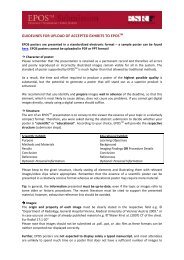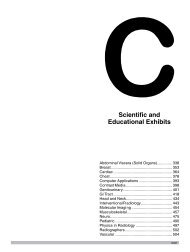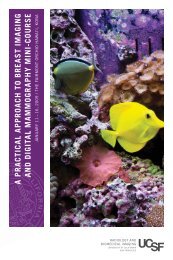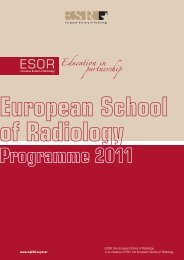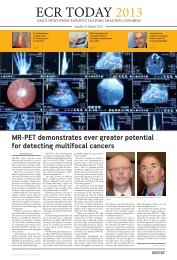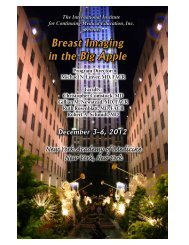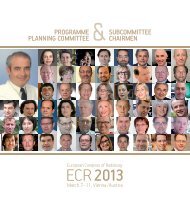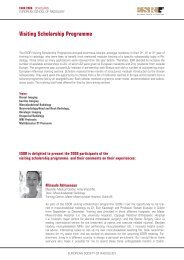ECR 2013 â Final Programme - myESR.org
ECR 2013 â Final Programme - myESR.org
ECR 2013 â Final Programme - myESR.org
- No tags were found...
You also want an ePaper? Increase the reach of your titles
YUMPU automatically turns print PDFs into web optimized ePapers that Google loves.
Postgraduate Educational <strong>Programme</strong>A-142 – A-15316:00–17:30 Room AInteractive Teaching SessionE³ 720a Neurological emergencies16:00A-142 A. Non-traumaticC. Ozdoba; Berne/CHLearning Objectives:1. To learn which imaging modality to use.2. To understand how to identify early ischaemia.3. To be able to select patients for treatment.16:45A-143 B. TraumaticM. Stajgis; Poznan/PLLearning Objectives:1. To understand the proper imaging protocols for trauma patients.2. To become familiar with imaging findings in acute head trauma.3. To learn about the imaging findings in spinal cord trauma.16:00–17:30 Room BESR meets E-AHPBAEM 2 Pancreatic cystic neoplasms <strong>2013</strong>Welcome by the ESR President:G.P. Krestin; Rotterdam/NLPresiding:J.I. Bilbao; Pamplona/ESP.-A. Clavien; Zurich/CH16:00A-144 IntroductionP.-A. Clavien 1 , K. Conlon 2 ; 1 Zurich/CH, 2 Dublin/IESession Objectives:1. To understand the importance of the recent WHO classification andits relevance to therapy.2. To become familiar with the radiological work-up for patients withpancreatic cystic tumours.3. To appreciate the current role of endoscopic ultrasonography indiagnosis and management.4. To become familiar with the indications for surgical intervention andthe role of <strong>org</strong>an-sparing therapies.16:03A-145 Classification/pathologyC. Verbeke; Stockholm/SELearning Objectives:1. To understand the morphological classification of pancreatic cysticlesions based on the distinction between neoplastic/non-neoplasticand epithelial/non-epithelial cysts.2. To become familiar with the key distinctive macroscopic featuresof the various cyst entities and to understand the basic microscopicdiagnostic features.3. To appreciate the considerable variation in macroscopic appearancesand the potential overlap between certain entities.4. To become familiar with the macroscopic features of malignanttransformation within primarily benign cystic lesions.16:21A-146 Radiological diagnosisS. Skehan; Dublin/IELearning Objectives:1. To become familiar with the optimal imaging modalities for cysticpancreatic lesions.2. To learn about the characteristic imaging features of cystic pancreaticlesions and to describe how imaging can contribute to preoperativediagnosis.3. To discuss the appropriate imaging surveillance of selected cysticpancreatic lesions.16:39A-147 Current role of endoscopic ultrasonographyP. Bauerfeind; Zurich/CHLearning Objectives:1. To appreciate the technical aspects, performance characteristics andlimitations of EUS and EUS-FNA in PCNs.2. To understand how EUS and EUS-guided FNA help to establish adiagnosis in PCNs.3. To appreciate the added information that EUS brings in staging premalignantand malignant PCNs and in orientating surgical decisionmaking.16:57A-148 How aggressive should the surgeon be?K. Conlon; Dublin/IELearning Objectives:1. To understand the clinical indications for surgical intervention.2. To appreciate the rationale for deciding on a particular procedure.3. To discuss the outcomes of observation versus surgery.Panel discussion:17:15 The multidisciplinary assessment and management ofpancreatic cystic neoplasia16:00–17:30 Room CNew Horizons SessionNH 7 Cartilage imaging16:00A-149 Chairman‘s introductionV.N. Cassar-Pullicino; Oswestry/UKSession Objectives:1. To review the basics of articular cartilage physiology.2. To introduce the quantitative MR tools used to assess collagen andproteoglycan depletion.3. To learn about the problems arising from the avascular nature ofarticular cartilage.16:03A-150 Sodium imagingS. Trattnig; Vienna/ATLearning Objectives:1. To get familiar with the basic principles of sodium imaging.2. To understand technical challenges of sodium imaging and how tohandle them.3. To learn about clinical applications of sodium imaging in cartilage,cartilage repair and other MSK structures.16:21A-151 dGEMRIC (delayed gadolinium-enhanced MR imaging ofcartilage)G. Welsch 1 , S. Trattnig 2 ; 1 Erlangen/DE, 2 Vienna/ATLearning Objectives:1. To learn the basic principles of dGEMRIC and the current usedtechniques for clinical imaging.2. To learn about the current clinical applications of dGEMRIC.3. To get an overview of future uses of dGEMRIC in therapeutic studies.16:39A-152 Diffusion tensor imagingC. Glaser; Munich/DELearning Objectives:1. To discuss basic principles of diffusion imaging in MSK.2. To review technical challenges and current achievements.3. To look into potential future directions.16:57A-153 CEST (chemical exchange saturation transfer)B. Schmitt; Vienna/ATLearning Objectives:1. To understand basic principles of CEST imaging.2. To learn about the current status of gagCEST imaging.3. To become aware of technical pitfalls and future approaches.168




